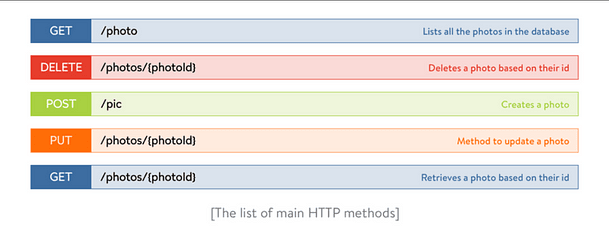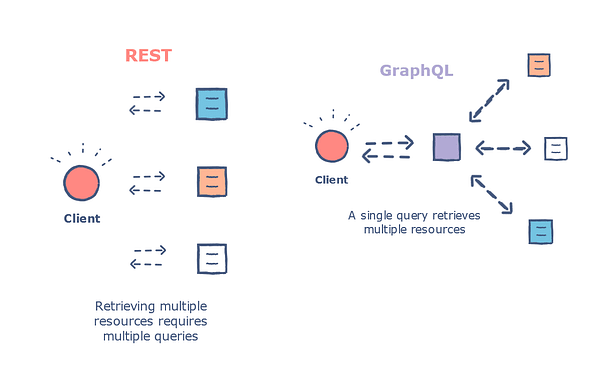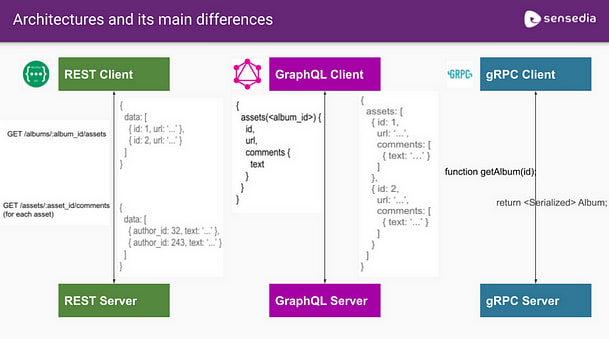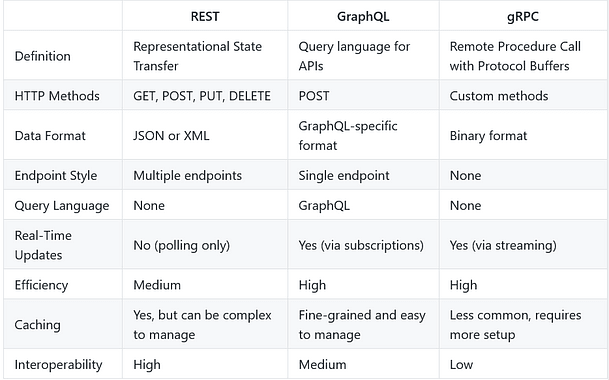📚 Difference between GraphQL, REST, and gRPC
💡 Newskategorie: Programmierung
🔗 Quelle: dev.to
Disclosure: This post includes affiliate links; I may receive compensation if you purchase products or services from the different links provided in this article.
image_credit - DesignGuru
Hello devs, if you are preparing for Coding interviews interviews the along with System Design, and Microsrvices, you should also prepare about things like REST, GraphQL, and gRPC like what is difference between REST, GraphQL, and gRPC?, which is also one of the popular questions on programming interviews.
Earlier, I have talked about difference between API Gateway vs Load Balancer and Horizontal vs Vertical Scaling, Forward proxy vs reverse proxy and difference between JWT, OAuth, and SAML and in this article, I am going to share my thoughts on REST, GraphQL, and gRPC, three popular communication protocols used for building web APIs.
They are used to allow different software components to communicate with each other over a network, for example Microservices can use REST for synchronous communication between them.
Each of these protocols has its own set of advantages and disadvantages, and understanding the differences between them is not just important from tech interview point of view but also important for choosing the right one for your project.
In this article, you will learn about the differences between REST, GraphQL, and gRPC. You will learn the core concepts behind each protocol, their strengths and weaknesses, and provide some use cases for when to use each one.
By the end of this article, you should have a better understanding of which protocol is best suited for your project's requirements.
By the way, if you are preparing for System design interviews and want to learn System Design in depth then you can also checkout sites like ByteByteGo, Design Guru, Exponent, Educative and Udemy which have many great System design courses
We will first start with some introduction then we will deep dive into each of them and then again revisit the difference so that you have clear understanding of their strength and weakness and when to use them.
REST stands for Representational State Transfer and it is a popular protocol used for creating web services that expose data and functionality over HTTP.
It is based on HTTP protocol and a set of constraints that define how resources are identified and addressed, and how operations can be performed on those resources.
On the other hand, GraphQL is a query language for APIs that was developed by Facebook. It allows clients to specify exactly what data they need, and the server responds with only that data.
GraphQL was created to address shortcomings and limitation of REST, hence it provides a more flexible and efficient way of fetching data from a server, as clients can request multiple resources in a single request.
And, gRPC is a high-performance, open-source protocol used for creating APIs. It uses Google's Protocol Buffers as a data format and provides support for streaming and bi-directional communication.
gRPC is often used in microservice architectures because of its performance and support for multiple programming languages.
Now that we know what they are let's deep dive into each of them.
What is REST? When to use it?
As I said, REST (Representational State Transfer) is an architectural style for designing distributed applications, particularly web-based APIs.
RESTful APIs use HTTP methods (such as GET, POST, PUT, DELETE) to perform CRUD (Create, Read, Update, Delete) operations on resources identified by a URL (Uniform Resource Locator).
If you know HTTP you know REST.
REST also relies on a stateless client-server architecture, where each request from the client contains all the information necessary for the server to fulfill the request, without needing to maintain session state.
Here are some scenarios when REST is a good choice:
When you need to expose data and services via an API because REST is a popular and well-established protocol for creating APIs that can be easily consumed by other applications and services.
When you need to support multiple platforms and programming languages because REST relies on standard HTTP methods and data formats, it can be used by a wide variety of programming languages and platforms.
When you need to support caching because REST supports caching, which can improve performance and reduce network traffic.
When you need to build simple, lightweight APIs
When you need to support a large number of resources
Also, understanding of HTTP methods are very important for designing a REST API. You can further see REST API Design, Development & Management course to learn about REST API design, development, and management.
Overall, REST is a flexible and widely adopted protocol that is a good choice for many types of APIs.
However, it may not be the best choice for all scenarios, particularly those that require real-time updates or more complex querying and data manipulation.
In those cases, other protocols such as GraphQL or gRPC may be more appropriate.
What is GraphQL? When to use it?
GraphQL is a query language for APIs that was developed by Facebook in 2012 and released as an open-source project in 2015. It was originally created to address limitation and shortcomings of REST.
GraphQL allows clients to define the structure of the data they need, and servers to respond with exactly that data, without any unnecessary data.
It's often used as an alternative to RESTful APIs, particularly for scenarios where the client needs fine-grained control over the data that's returned.
Here are some scenarios when GraphQL is a good choice:
When you want to reduce network traffic as GraphQL allows clients to specify exactly what data they need, which can reduce the amount of unnecessary data that's transmitted over the network.
When you need to support a wide variety of clients because GraphQL supports strongly-typed queries, which can be used to ensure that clients receive the correct data in a format they understand.
When you need to support real-time updates as GraphQL supports real-time updates via subscriptions, which allow clients to receive updates as soon as they're available.
When you need to support complex queries and data manipulation: because GraphQL allows clients to perform complex queries and data manipulation operations, such as filtering, sorting, and aggregation, with a simple syntax.
When you need to support versioning because GraphQL supports versioning by allowing clients to specify the version of the schema they're using in their requests, which can make it easier to maintain backward compatibility as the schema evolves over time.
Overall, GraphQL is a powerful and flexible protocol that can be a good choice for scenarios where fine-grained control over data and real-time updates are important.
However, it may require more setup and configuration than RESTful APIs, particularly if you're working with multiple programming languages or platforms.
You can further see GraphQL by Example and GraphQL with React: The Complete Developers Guide to learn more about GraphQL and how to use it.
and Here is also a nice diagram highlighting the difference between REST and GraphQL queries:
What is gRPC? When to use it?
Now let's see what is gRPC and what does it offer? Well, gRPC is a high-performance, open-source framework for remote procedure calls (RPC) developed by Google.
It uses Protocol Buffers as the interface description language and supports a wide range of programming languages, making it easy to build distributed systems that work across different platforms and environments.
Here are some scenarios when gRPC is a good choice:
When you require high performance and efficiency because gRPC uses a binary protocol and supports streaming, which can make it much faster and more efficient than other protocols, particularly over high-latency or low-bandwidth connections.
When you require to support a wide range of programming languages because gRPC supports many programming languages, including Java, C++, Python, and Go, making it easy to build distributed systems that work across different platforms and environments.
When you need to support real-time updates because gRPC supports bidirectional streaming, which allows servers to send updates to clients in real-time.
When you need to work with large amounts of data since gRPC uses Protocol Buffers, which are more efficient and compact than other data formats like JSON or XML, making it a good choice for working with large amounts of data.
When you need to build microservices or distributed systems because gRPC provides a powerful and flexible framework for building microservices and distributed systems that can scale horizontally and handle large volumes of traffic.
Overall, gRPC is a powerful and efficient protocol that can be a good choice for scenarios where performance, efficiency, and real-time updates are important.
However, it may require more setup and configuration than other protocols like RESTful APIs, particularly if you're working with multiple programming languages or platforms.
You can further see Complete Guide to Protocol Buffers 3 [Java, Golang, Python] and gRPC [Java] Master Class: Build Modern API & Microservices to learn more about gRPC and Google Protocol buffer.
Here is a nice diagram which highlights the difference between REST, gRPC and GraphQL request as well
image_credit --- https://medium.com/@LadyNoBug/grpc-v-s-rest-v-s-others-5d8b6eaa61df
Difference between GraphQL, REST and, gRPC
Now that you know what is REST, gRPC, and GraphQL and how they work, here are the key differences between REST, GraphQL, and gRPC in point format remember their key characteristic and when to use each of them in your project:
REST:
- Stands for Representational State Transfer
- Uses HTTP methods (GET, POST, PUT, DELETE) to perform CRUD operations
- Sends data in a structured format, usually JSON or XML
- Can have multiple endpoints for different resources
- Clients receive all the data specified in the response, even if they don't need it all
- Caching is supported, but can be complex to manage
- Well-established and widely adopted, with extensive tooling and documentation available
GraphQL:
- Allows clients to specify exactly what data they need, and receives only that data
- Uses a single endpoint to access multiple resources
- Has its own query language that allows for complex data fetching and manipulation
- Can support real-time updates via subscriptions
- Can be more efficient than REST in certain situations, particularly for mobile devices with limited bandwidth
- Caching can be more fine-grained and easier to manage than with REST
- Requires more setup and configuration than REST, and may require more expertise to use effectively
gRPC:
- Stands for Remote Procedure Call (RPC) with Google's Protocol Buffers
- Uses binary data for communication instead of HTTP
- Supports streaming data for real-time updates
- Uses protocol buffers for serialization, which can be more efficient than JSON or XML
- Can be used across different programming languages
- Designed for high-performance, low-latency communication between microservices
- Requires more setup and configuration than REST, and may require more expertise to use effectively
- Can be less interoperable than REST or GraphQL, since it is not based on HTTP
Here is also a nice table which highlight the difference between REST, GraphQL, and gRPC, you can use it for quick revision:
It's also worth noting that these protocols are not mutually exclusive, and it's possible to use them in combination to take advantage of their different strengths.
For example, you might use REST for most of your API, but use GraphQL for certain resource-intensive queries, or use gRPC for communication between microservices while using REST or GraphQL for external API clients.
System Design Interviews Resources:
And, if you are preparing for System design interview then here are curated list of best system design books, online courses, and practice websites which you can check to better prepare for System design interviews.
DesignGuru's Grokking System Design Course: An interactive learning platform with hands-on exercises and real-world scenarios to strengthen your system design skills.
"System Design Interview" by Alex Xu: This book provides an in-depth exploration of system design concepts, strategies, and interview preparation tips.
"Designing Data-Intensive Applications" by Martin Kleppmann: A comprehensive guide that covers the principles and practices for designing scalable and reliable systems.
LeetCode System Design Tag: LeetCode is a popular platform for technical interview preparation. The System Design tag on LeetCode includes a variety of questions to practice.
"System Design Primer" on GitHub: A curated list of resources, including articles, books, and videos, to help you prepare for system design interviews.
Educative's System Design Course: An interactive learning platform with hands-on exercises and real-world scenarios to strengthen your system design skills.
High Scalability Blog: A blog that features articles and case studies on the architecture of high-traffic websites and scalable systems.
YouTube Channels: Check out channels like "Gaurav Sen" and "Tech Dummies" for insightful videos on system design concepts and interview preparation.
ByteByteGo: A live book and course by Alex Xu for System design interview preparation. It contains all the content of System Design Interview book volume 1 and 2 and will be updated with volume 3 which is coming soon.
Exponent: A specialized site for interview prep especially for FAANG companies like Amazon and Google, They also have a great system design course and many other material which can help you crack FAAN interviews.
image_credit - ByteByteGo
Conclusion
That's all about difference between REST, GraphQL, and gRPC technology. In short, REST is a popular protocol used for creating web services, inspired by HTTP and take full advantages of what HTTP offers, while GraphQL is a query language that allows clients to specify exactly what data they need from a server.
It was created to address shortcoming of REST, so its definitely a viable option if you are struggling to maintain your REST APIs.
On the other hand, gRPC is a high-performance, open-source protocol that is often used in microservice architectures.
Each of these protocols serves a different purpose, and they can all be used together to provide a comprehensive and efficient communication system for web applications.
...

 800+ IT
News
als RSS Feed abonnieren
800+ IT
News
als RSS Feed abonnieren





